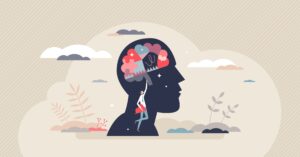
Hypothalamus: the importance of hormones in the brain
What is the hypothalamus? Let’s start by painting a picture: Your stomach starts churning. It’s been hours since you last ate and you can feel the hunger intensely. You start craving every food available and it starts to become difficult to concentrate. The only thing you can think about is food and it becomes too uncomfortable to bear so you decide to eat. Does this sound familiar?
If you want to learn in depth about the hypothalamus don’t miss “the extend further” section at the end of this article!
The responsible of this whole process is the hypothalamus, a small sub-cortical structure located in the center of the brain. Being only the size of a pea, the hypothalamus is in charge of regulating different functions that are essential to our day to day life, such as eating and homeostasis. If it weren’t for the hypothalamus, we wouldn’t know when we needed to eat and we would end up dying of hunger.

It modules the food intake by increasing or decreasing hunger and satiation awareness. – Ali Inay on Unsplash
What is the Hypothalamus?
The hypothalamus and the thalamus are part of the diencephalon. They are part of the limbic system and contain the main diversity in neurons of the whole brain. It’s in charge of the autonomic nervous system and the endocrine system. It’s an endocrine gland that releases hormones in charge of modulating behaviors relating to species maintenance. It also regulates hormone secretion of the hypophysis (pituitary gland) with whom it shares the hypothalamic-pituitary-adrenal axis. It’s made of two different secreting neurons: The parvocellular (who secrete peptidic hormones) and the magnocellular (which secrete neurohypophysial hormones).
Where is the Hypothalamus located?
Having a perfect spot in the brain is important. It is located in a brain part just beneath the thalamus (from there the name) and right above the brainstem. It connects with the hypophysis through the pituitary stalk. The hypothalamus central position allows it to communicate perfectly, receiving information from different body structures and sending information to others.
What does the Hypothalamus do? How does it keep us alive?
Its functions are essential to our daily life. It is responsible for maintaining the body’s systems, including body temperature, body weight, sleep, mating, levels of aggression and even emotional regulation. Most of these functions are regulated by a chain of hormones that inhibit or release between themselves.
- Hunger: when our body detects that we have don’t have enough energy saved, it sends Ghrelin (hunger hormone) to the hypothalamus, telling us we need to eat. It then releases a neuropeptide that produces the hunger feeling in our body. In the painted picture above our body is producing so many neuropeptides that we feel overwhelmed by hunger.
- Satiation: when we have eaten enough, our body has to tell our brain that we don’t need any more food and that we need to stop eating. While we are eating our body produces insulin which in turn increases the production of a hormone called Leptin. Leptin travels through our blood until it reaches the ventromedial nucleus of the hypothalamus. This inhibits the production of neuropeptides, therefore, stopping the hunger sensation.
- Thirstiness: Similar to hunger, when the body is thirsty it releases an antidiuretic hormone (vasopressin) that allows for the body not to lose water and stimulate drinking more.
- Temperature: The blood temperature when it arrives at the hypothalamus will determine if we need to reduce or increment our body temperature. If the temperature is too high, we need to lose heat, therefore, the anterior portion with inhibit the posterior, producing certain events such as sweating, in order to lower heat. On the other hand, when the temperature is too low, the posterior portion will inhibit the anterior. This will enable the release of a thyroid stimulating hormone (TSH) and the adrenocorticotropic hormone (ACTH), both helping heat conservation.
- Sleep: The reason why it’s so difficult to sleep with the light on is because of the hypothalamus. The sleep cycle is regulated by circadian rhythms, which in turn are managed by a set of neurons in the medial hypothalamus called the suprachiasmatic nucleus. This nucleus receives information from ganglion cells in the retina through the optic nerve tract. This way the retina is capable of detecting a change in lighting and sends the information back to the hypothalamus. The set of neurons process the information and then it is sent to the pineal gland. If there is no light, the pineal gland will secrete melatonin (sleep hormone). If there is light, the gland reduces melatonin levels which promotes wakefulness.
- Mating and Aggression: Even though these behaviors are opposites they are highly related in the animal world and are also regulated by the hypothalamus. Some neurons are stimulated when there is mating behavior present while others when there is aggression. However, there are other neurons that happen to respond to both scenarios. The amygdala sends in information related to the aggressive area in the hypothalamus so that it can release important and pertinent hormones depending on the situation.
- Emotions: when we experience an emotion this comes with many physiological changes. For example, when walking in a dark alley by yourself the natural response is to feel fear. Therefore the body has to prepare to respond appropriately given the circumstance. So, the hypothalamus sends information to the different parts of the body (increasing our breathing rate, contraction of the blood vessels, pupil dilation and muscle contraction). This way, the hypothalamus allows us to detect threats and run if necessary away from it. That being so, it enables the physical response to the emotion.
What relationship does the hypothalamus have with love?
One of the most important brain functions is processing emotions. These emotions are processed in the limbic system. The hypothalamus is a big part of this system since it’s in charge of letting the whole body know what emotion the brain is feeling. How emotions work in the brain is a complex task, nevertheless, the hypothalamus is responsible for how we feel love. The hypothalamus produces phenylethylamine, a type of neurotransmitter with similar effects to amphetamines. This is the reason why when we fall in love we feel happy and euphoric. This neurotransmitter also leads to an increase in adrenaline and noradrenaline, which rises the heartbeat, oxygen levels and blood pressure (triggering the sensation of your “heart skipping a beat”).
On the other hand, the brain also produces dopamine and serotonin, which allows us to focus our attention on the person that makes us feel these emotions and regulate our emotions accordingly. Consequently, the hypothalamus is very important since without it, we wouldn’t be able to fall in love.

Without the it, we wouldn’t be capable of falling in love.
What link is there between the hypothalamus and the hypophysis (pituitary gland)?
The hypothalamus regulates the emission of hormones from the hypophysis. The hypophysis is also an endocrine gland and its under the hypothalamus, protected by the sella turcica (bone structure in the base of the cranium). The pituitary gland function is to secrete hormones, under the hypothalamus command, through the blood that our body needs to maintain homeostasis (level our temperature or balance different hormones). Their relationship is so close that they form the hypothalamic-pituitary-adrenal axis and they couldn’t work separately. The hypophysis allows for the hypothalamus to extends its effects to the rest of the body.
What happens when the hypothalamus is disturbed? In what disorders o diseases is the hypothalamus involved?
Given the relevance of the hypothalamus, an injury in any of the hypothalamus’ nuclei can be fatal. For example, if the satiation center is damaged (not being capable of being satiated), we wouldn’t stop eating and therefore eat non-stop with a high risk to what this conveys. Some of the most frequent pathologies are:
- Diabetes insipidus: It is when the supraoptic, paraventricular and the supraoptic hypophysial fasciculus nuclei are injured. Due to low production of ADH, there is more liquid intake and more urine output.
- Injury in the caudolateral hypothalamus: If this region is damaged all sympathetic activity of the nervous system will diminish including body temperature.
- Injury in the medial hypothalamus: all parasympathetic activity of the nervous system will be damaged but the body temperature will rise.
- Korsakoff Syndrome: with the mammillary nucleus (related to the hippocampus) altered, there will be anterograde amnesia, the person will have difficulty remembering new information in long-term memory. Since remembering is difficult, people with this syndrome tend to use fabrications to fill the gaps. This disorder is usually associated with chronic alcoholism it can also happen as an alteration in the mammillary tubers and their connections.
To extend further…
What hormones are produced in the hypothalamus?
The hypothalamus function is through hormone release. Some of the hormones are:
- Neurohormones: Antidiuretic hormone and oxytocin.
- Hypothalamic factors: The hypothalamus uses corticotropin-releasing hormone (CRH or corticoliberin), thyrotropin-releasing hormone (TRH), gonadotropin-releasing hormone (GnRH or gonadoliberin), growth hormone–releasing hormone (GHRH or somatoliberin).
Of what nuclei is the hypothalamus made of and what is their purpose?
Each nuclei has a main purpose:
- Arcuate nucleus: it’s part of the emotional function of the hypothalamus. Its endocrine function consists of synthesizing hypothalamic peptides and neurotransmitters. In charge of liberating the gonadotropin hormone.
- Anterior hypothalamic nucleus: it’s in charge of releasing the heat when sweating. It’s also in charge of liberating thyrotropin in the hypophysis.
- Posterior hypothalamic nucleus: Its function is to keep the heat inside the body when it’s cold.
- Lateral hypothalamic nucleus: it regulates thirst and hunger. When it detects a lack of sugar or water it tries to find homeostasis.
- Mammillary nucleus: given its connections with the hippocampus, it’s related to the memory.
- Paraventricular hypothalamic nucleus: It regulates hormone release from the hypophysis (oxytocin, vasopressin, and corticotropin).
- Preoptic Nucleus: it influences functions such as nutrition, locomotion, and mating.
- Supraoptic nucleus: It regulates arterial pressure and liquid equilibrium through the antidiuretic hormone.
- Suprachiasmatic nucleus: In charge of hormones relating to circadian rhythms.
- Ventromedial nucleus: its role consists of regulating satiation.
From where does the hypothalamus receive information? Where does it send it?
The hypothalamus has great different connections due to the brain area where it’s located. On one side, it receives information from other structures (afferent) and then sends information to other parts of the brain (efferent).
Afferents
- Reticular cephalic flexure: From the cephalic flexure to the lateral mammillary nucleus.
- Median prosencephalic fasciculus: from the olfactory region, septal nuclei and amygdala region to the preoptic lateral and lateral hypothalamus.
- Stria terminalis: from the hippocampus to the septum and mammillary nucleus.
- Precommissural fornix fibers: connect with the dorsal hypothalamic area, septal nuclei and preoptic lateral nucleus.
- Postcommissural fornix fibers: takes the information to the medial mammillary nucleus.
- Retinohypothalamic fibers: Take information from the amount of light in the retina and sends it to the suprachiasmatic nucleus for circadian rhythm regulation.
- Cortical projections: receives information from the cerebral cortex and sends it to the hypothalamus.
Efferents
- Dorsal longitudinal fasciculus: from the medial and periventricular regions of the hypothalamus to the grey matter.
- Mammillary efferent fibers: From the medial mammillary nucleus to the anterior thalamic nuclei, and also from the mesencephalon to the ventral nuclei.
- Supraoptic nucleus: from the supraoptic nuclei to the posterior lobe of the hypophysis.
- Tuberohypophyseal: from the nuclei arcuati to the infundibular stalk.
- Descendent projections to the brainstem and spinal cord: from the paraventricular nucleus to the solitary nucleus and the ventrolateral regions of the medulla oblongata.
- Efferent projections to the suprachiasmatic nucleus: it connects directly with the pineal gland.
Questions? Leave a comment below 🙂
This article was originally written in Spanish by David Asensio Benito, translated by Alejandra Salazar.













